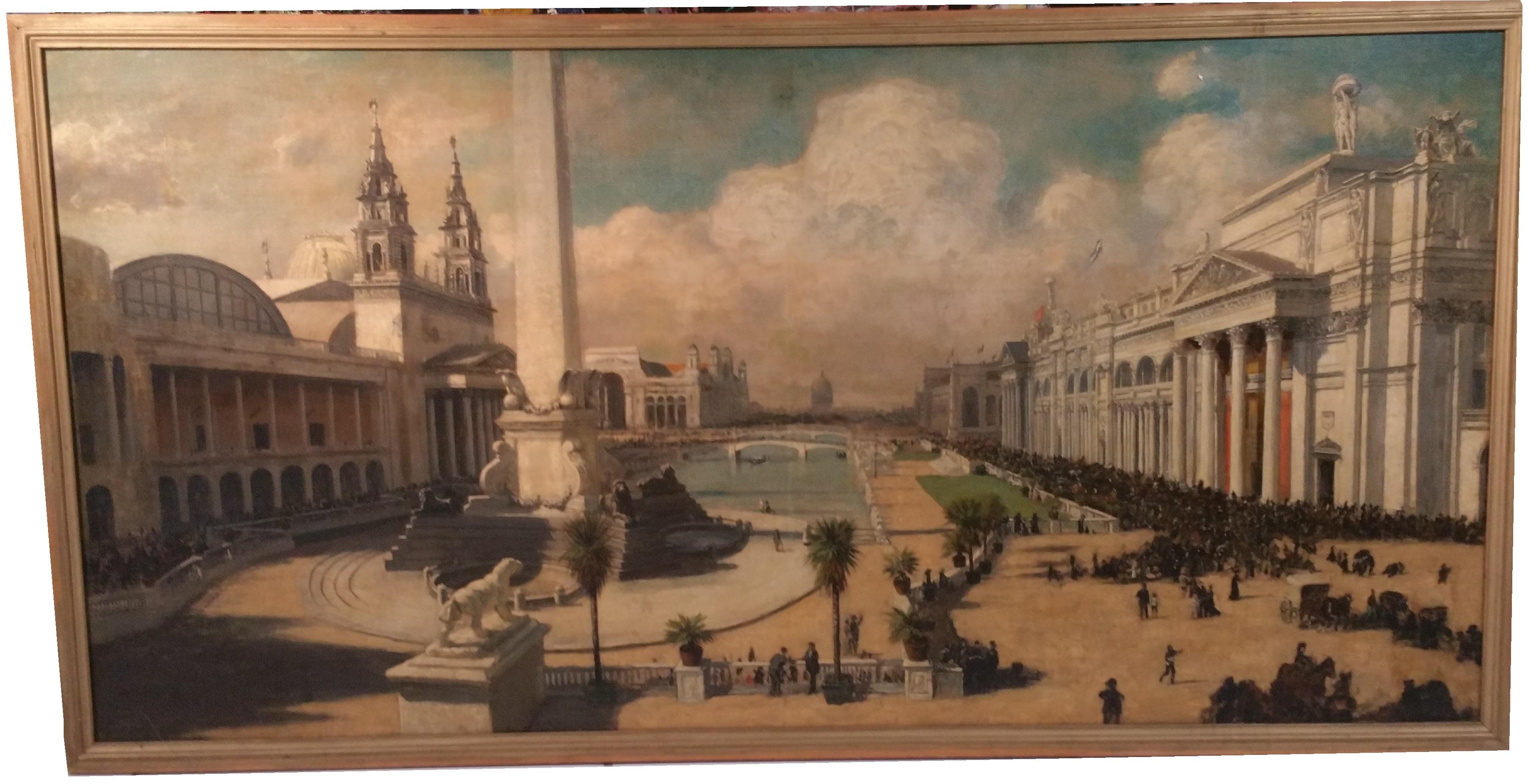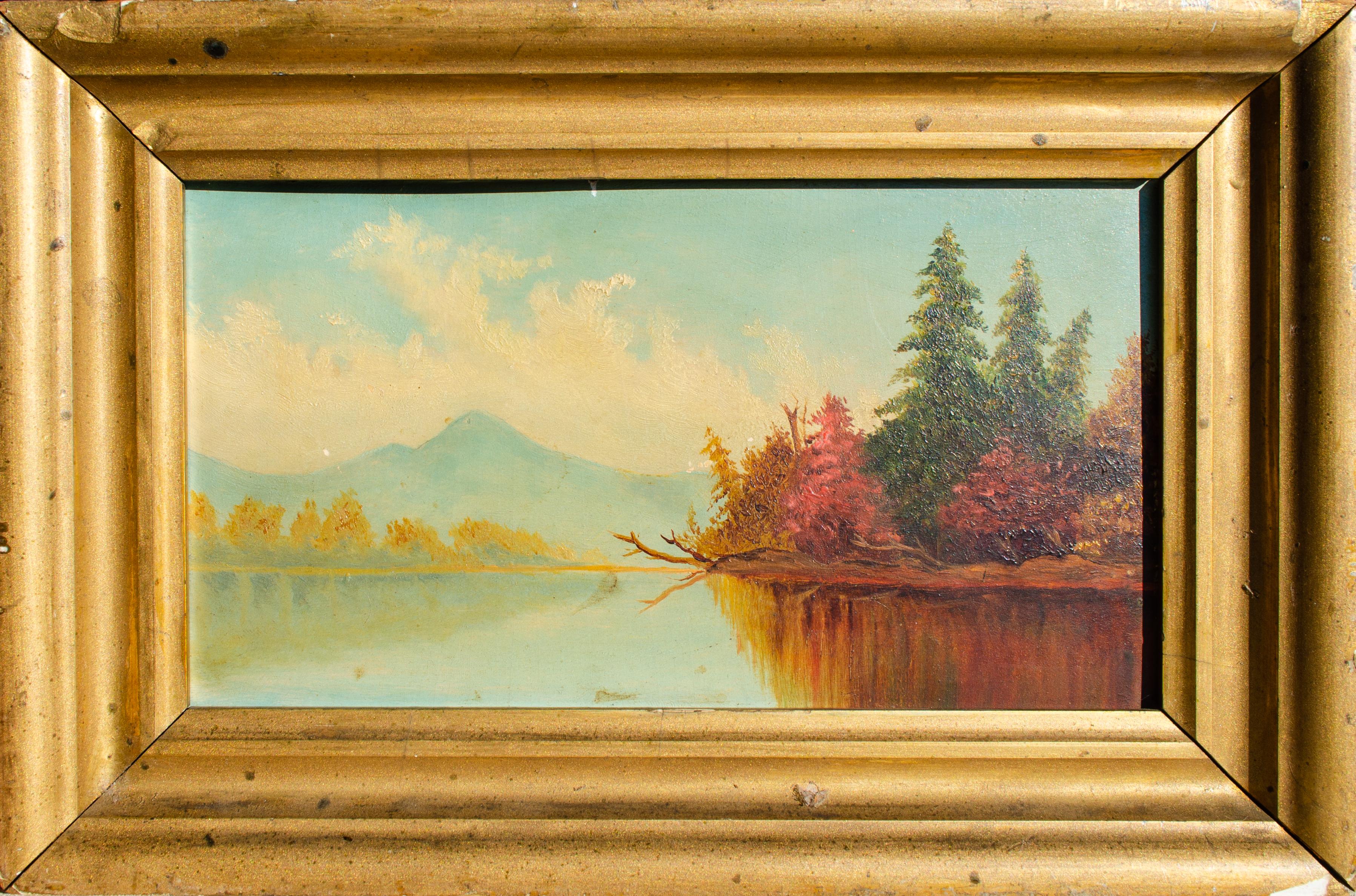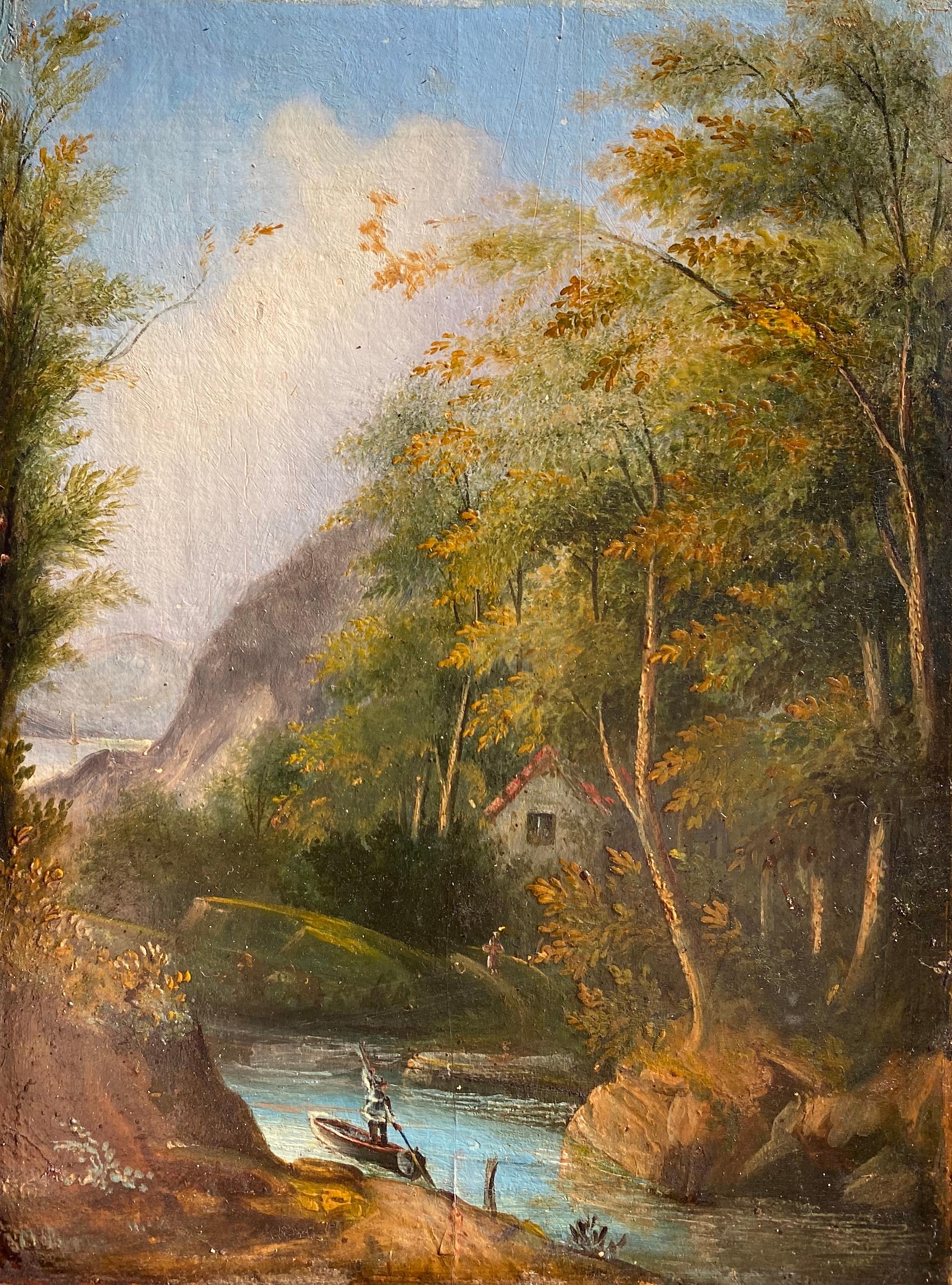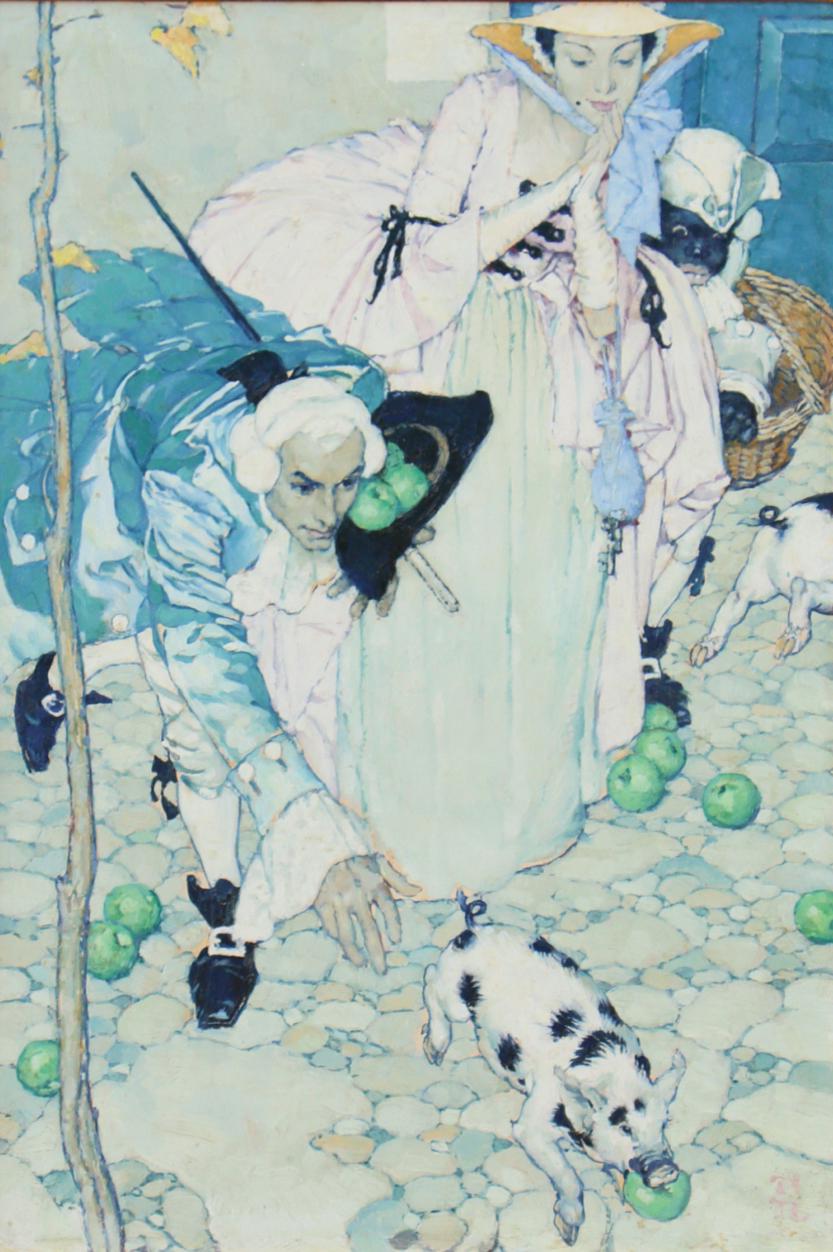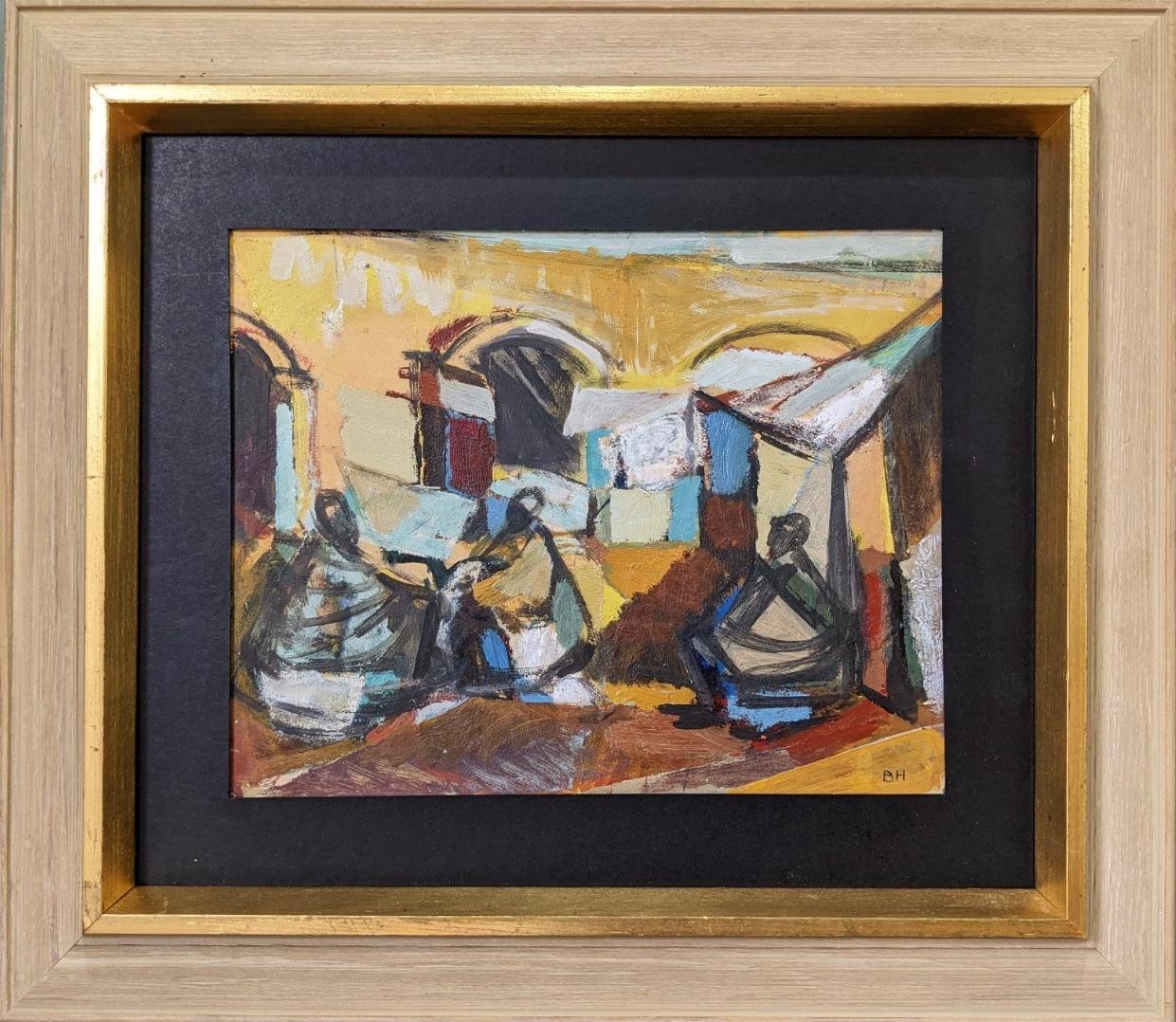Items Similar to The Warning
Want more images or videos?
Request additional images or videos from the seller
1 of 6
Edward Lawson HenryThe Warning
About the Item
Edward Lamson Henry (American, (1841 - 1919))
“The Warning”
Grisaille on paper mounted on board, signed lower left ‘E L Henry’ (partially obscured by frame)
22x 15 inches
Provenance: Albert Duveen Collection, Theodore Stebbins (Professor at Yale University), Sotheby’s 1970s.
McCausland, E. L. Henry, 1945, Catalogue 67a, illustrated figure 104, Exhibition: Century Association 1942, No. 58
Description
In E. L. Henry’s “The Warning” a young African American man burst into a rustic and rural interior to warn Civil War era soldiers, startled from their chairs, at lower left, of impeding danger. The inclusion of a wounded soldier, at the immediate far right, adds a sense of clandestine romanticism to the scene. Executed in grisailles on paper, the dusty tones lend a feeling of age in the mind of the artist. Romanticized genre scenes depicting the Civil War were popular with collectors, veterans, and families. The horrific yet still ennobled war, which decimated and destroyed communities as well as a way of life in the Southern states were representative of historical remembrance. A veteran of the Union Army, Henry began painting scenes inspired by his experiences shortly after the war.
About the artist
Born in Charleston, South Carolina and orphaned at an early age, Edward Lamson Henry had sufficient means, family ties and social connections to enter the art circles of New York at the highest level. Following early art studies in that city with Walter Mason Oddie, he enrolled in the Pennsylvania Academy of the Fine Arts in Philadelphia in 1858, coming under the instruction of Paul Weber. His most formative period, however, occurred in Paris between 1860 and 1862 at the prestigious École des Beaux-Arts. There, he worked with the academicians Joseph-Nicholas Robert-Fleury and Marc-Charles-Gabriel Gleyre, whose penchant for scenes of classical antiquity cast in nostalgic terms exerted a permanent influence. Henry returned to New York in 1862 and established a studio at the popular Tenth Street Studio Building.
During the Civil War, Henry served as captain's clerk on board a Union supply ship in the James River. From this vantage point, he made a series of sketches, dating to 1864, based on his observations of the Virginia countryside under siege from Union forces. Station on the Morris and Essex Railroad, also painted in 1864, marked the beginning of Henry's interest in sentimental depictions of antiquated train stations. He was elected an associate of the National Academy of Design in 1867 and elevated to full academician in 1869. That same year, The Old Westover House, a painting based on the artist's war sketches, was exhibited, the earliest of a series of works which recounted.
transformations in Southern life and culture. Henry made a study trip to Europe in 1871 and, upon his return in 1872, completed his monumental City Point, Virginia, Headquarters of General Grant. President Grant was said to be so taken with the accuracy of the painting that he invited the artist to the White House. At that meeting, the president told Henry that "we are the men who make history, but you are the men who perpetuate it."
From 1875 to 1880, Henry and his wife lived in London where he exhibited at the Royal Academy and the Suffolk Street Gallery, home of the Gallery of British Artists, specialists in traditional historical genre painting. From an address in London, Henry exhibited at the 1878 Universal Exposition in Paris. Beginning in the 1880s, Henry became a central figure in the emerging summer art colony of Cragsmoor, located in Ulster County, New York, which later attracted such noted painters as Frederick Samuel Dellenbaugh, Helen Maria Turner and Charles Courtney Curran.
In a tribute read at the annual meeting of the National Academy of Design following Henry's death, academy president Samuel Herbert Adams noted that no one could "doubt the peculiar historic interest as well as the genuine charm of the paintings of Edward Lamson Henry" whose "art has a characteristic American quality."
Henry's work can be found in the collections of the Smithsonian American Art Museum, Metropolitan Museum of Art, Corcoran Gallery of Art, New-York Historical Society and Terra Foundation for American Art.
- Creator:Edward Lawson Henry (1841 - 1919, American)
- Dimensions:Height: 15 in (38.1 cm)Width: 23 in (58.42 cm)Depth: 3 in (7.62 cm)
- Medium:
- Movement & Style:
- Period:
- Condition:
- Gallery Location:Saratoga Springs, NY
- Reference Number:1stDibs: LU17028428822
About the Seller
4.2
Vetted Seller
These experienced sellers undergo a comprehensive evaluation by our team of in-house experts.
Established in 1992
1stDibs seller since 2015
30 sales on 1stDibs
Typical response time: 19 hours
- ShippingRetrieving quote...Ships From: Saratoga Springs, NY
- Return PolicyA return for this item may be initiated within 3 days of delivery.
More From This SellerView All
- The Columbian Exhibition, the 1893 Chicago World’s FairLocated in Saratoga Springs, NYThaddeus Welch (American 1844-1919) The Columbian Exhibition, the 1893 Chicago World’s Fair 70 x 35”, oil on board signed Request Price The C...Category
Late 19th Century Hudson River School Figurative Paintings
MaterialsOil, Board
- Impressions de New York No. 3Located in Saratoga Springs, NYDavid Solot, a dentist and painter, was born in Falciu (Romania) and settled in Paris in 1928. His art was surrealistic dentally inspired plus portraits and city landscapes. **************************** Translated from an article by Luana Hrisanti Rigot: "In 1956, at the Charlotte Norberg Gallery (Paris), he presented his first personal exhibition, composed of an ensemble of surrealist paintings of professional inspiration (dental elements). Two years later, at Gallery Royale (Rochefort), he exhibits another 50 paintings on the subject. At that time, a decisive event for the painter David Solot was made: a great new-York-born antibiotic producer Lederle Cy learns about his work and contacts him through the US Ambassador to Paris, proposing an advertising contract and buying the reproduction right for 24 of its canvases. A year later, the same company bought the right to print three of its cloths in color. This was the starting point of his international notoriety. In 1959, the American Dental...Category
1960s Impressionist Figurative Paintings
MaterialsBoard, Oil
- Brooklyn Bridge, New YorkLocated in Saratoga Springs, NYDavid Solot, a dentist and painter, was born in Falciu (Romania) and settled in Paris in 1928. His art was surrealistic dentally inspired plus portraits and city landscapes. **************************** Translated from an article by Luana Hrisanti Rigot: "In 1956, at the Charlotte Norberg Gallery (Paris), he presented his first personal exhibition, composed of an ensemble of surrealist paintings of professional inspiration (dental elements). Two years later, at Gallery Royale (Rochefort), he exhibits another 50 paintings on the subject. At that time, a decisive event for the painter David Solot was made: a great new-York-born antibiotic producer Lederle Cy learns about his work and contacts him through the US Ambassador to Paris, proposing an advertising contract and buying the reproduction right for 24 of its canvases. A year later, the same company bought the right to print three of its cloths in color. This was the starting point of his international notoriety. In 1959, the American Dental...Category
1960s Impressionist Figurative Paintings
MaterialsOil, Board
- Two Women WalkingBy Reginald MarshLocated in Saratoga Springs, NYA double sided painting. An urban realist painter of New York City genre, Reginald Marsh devoted his career to depicting people going about their everyday business including Bower...Category
Mid-20th Century Figurative Paintings
MaterialsBoard, Oil
- Lady Posing in a Red DressLocated in Saratoga Springs, NYHarry Jelinek (1905-1986) “Lady Posing in a Red Dress” Signed and dated 1965 Acrylic on boardCategory
1960s Post-Modern Figurative Paintings
MaterialsBoard, Acrylic
- Sand Lot BaseballBy Ralph FasanellaLocated in Saratoga Springs, NYSigned lower right and dated 1954. Bio: FASANELLA, RALPH (1914-97) was a self-taught painter who created large, colorful and intricate paintings of working-class culture and American politics from 1945 until his death in 1997. Fasanella had an artistic vision born of a working life. A child of Italian immigrants, he spent his youth delivering ice with his father and enduring the harsh regimen of a Catholic reform school. During the Great Depression, Fasanella worked in garment factories and as a truck driver. From his mother—a literate, sensitive, and progressive woman, Fasanella acquired a social conscience. Through her influence he became active in antifascist and trade union causes. Fasanella's political beliefs were radicalized by the Depression. His antifascist zeal led him to volunteer for duty in the International Brigades fighting fascism in Spain, where he served in 1937-1938. Upon his return to New York City Fasanella became an organizer for various unions, particularly the United Electrical, Radio, and Machine Workers of America, with whom he achieved some major organizing successes. In 1945, disillusioned by the labor movement and plagued by a painful sensation in his fingers, Fasanella started to draw. He left organizing and began to paint full time. He painted obsessively, capturing the vibrant moods of the city and the tumult of American politics. For a brief time he received some critical notice for his work, and had shows of his work in galleries as well as union halls. Fasanella included in his paintings a profusion of brightly colored details, showed interiors and exteriors simultaneously, and combined past and future. He populated his paintings with likenesses of family and friends. In 1950 Fasanella married Eva Lazorek, a schoolteacher who supported the couple through over two decades of artistic obscurity and blacklisting by the FBI. In the 1950s Fasanella retreated from political content in his works out of fear of reprisals. With the emergence of the New Left in the 1960s, however, his works became large, sharply focused political essays using images from the popular media. In 1972 Fasanella was featured in "New York" magazine and in an illustrated coffee-table book, "Fasanella's City". His large-scale, intricate paintings of urban life and American politics were then introduced to art critics and the public. In the late 1970s Fasanella spent two years in Lawrence, researching the 1912 Bread and...Category
1950s Other Art Style Figurative Paintings
MaterialsCanvas, Oil
You May Also Like
- Livestock LandscapeBy Eugène Joseph VerboeckhovenLocated in Fredericksburg, VAEugène Joseph Verboeckhoven, a luminary of 19th-century Belgian art, wielded his brush with unparalleled mastery, capturing the timeless allure of pastoral landscapes and noble anim...Category
Mid-19th Century Hudson River School Figurative Paintings
MaterialsOil, Board
- 19th Century White Mountain Landscape, Unknown American SchoolLocated in Larchmont, NYUnknown White Mountain Artist White Mountain Landscape, 19th Century Oil on board 5 x 9 1/4 in. Framed: 7 3/4 x 11 3/4 in.Category
19th Century Hudson River School Figurative Paintings
MaterialsOil, Board
- “Worcester, Massachusetts”Located in Southampton, NYOil on wood panel painting of a Worcester, Massachusetts view by local resident artist Mabel Blake. Signed M. Blake lower left. Circa 1880. Condition is good. The bucolic scene depicts a man in a boat...Category
1880s Hudson River School Figurative Paintings
MaterialsBoard, Oil
- Swords at WeehawkenBy Norman RockwellLocated in Fort Washington, PADate: 1938 Medium: Oil on Paperboard Sight Size 20.25" x 13.875", Framed to 27.50" x 21.00" Signature: Signed Lower Right with Initials: N/R 'Philip found himself involved in a humi...Category
1930s Figurative Paintings
MaterialsLaid Paper, Oil, Board
- Vintage Swedish Figurative Oil Painting, Brita Hansson - Market SquareLocated in Bristol, GBMARKET SQUARE Size: 37 x 42 cm (including frame) Oil onto paper laid to board A richly coloured mid century modernist figure scene, painted in oil onto paper laid on board, by the ...Category
1950s Modern Figurative Paintings
MaterialsOil, Board, Laid Paper
- Hudson River School Style Painting, Signed BrundellLocated in Larchmont, NYG. Brundell Untitled, c. Early 20th Century Oil on canvas Sight: 10 x 18 in. Framed: 19 7/8 x 27 7/8 x 2 in. Signed lower leftCategory
Early 20th Century Hudson River School Landscape Paintings
MaterialsCanvas, Oil
Recently Viewed
View AllMore Ways To Browse
The Way We Were
Hudson Street
Robert Hudson
African American Antique
Hudson River School Gallery
Henry Read
1970s Ships Painting
President Grant
Edward Train
Antique African American Art
Civil War Generals
River Of No Return
African American 19th Century
Union Civil War
Train Station Painting
Paul Weber
19th Century Paris Street Scene
Henry Hudson
